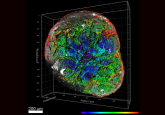CRISPR-based diagnostics: expanding the toolbox against COVID-19

A promising new tool uses CRISPR technology and, uniquely, the Cas13d enzyme to provide faster results than PCR tests for detecting SARS-Cov-2.
Researchers at The University of California, San Diego (CA, USA) have developed a diagnostic tool called Sensitive Enzymatic Nucleic Acid Sequence Reporter (SENSR) using CRISPR technology to identify pathogens from their DNA or RNA sequences. PCR tests need specialist facilities and long reaction times which limit their application; SENSR promises the development of more practical, simple technologies for detection.
SENSR uses the Cas13d enzyme, specifically a ribonuclease effector called CasRx, and is the first of its kind to do so. Commonly, Cas9 is used in genetic engineering with CRISPR; however, more recently enzymes including Cas12a and Cas13a have been explored for accurate CRISPR-based diagnostics. Looking into different enzymes related to those currently used in genetics-based diagnosis methods, as was done in this study, will expand this technology’s scope and potential application.
“CRISPR has significantly advanced our capabilities for rapid identification of infected individuals and offers point-of-case testing in low-resource settings that previously wasn’t possible,” says Omar Akbari, who leads the research group.
 How effective is a COVID-19 booster vaccine?
How effective is a COVID-19 booster vaccine?
The largest real-world observational study of the third ‘booster’ dose of mRNA COVID-19 vaccine demonstrates its effectiveness against severe SARS-Cov-2-related illness, hospitalization and death.
The early results of the study indicate that SENSR is able to give an accurate diagnosis of SARS-Cov-2 in less than an hour. Like the now very familiar lateral flow test, the research group hopes to make this technology useable from the comfort of your home. “SENSR further opens the toolbox for CRISPR diagnostic systems and will help detect emerging pathogens before they become pandemics,” says Akbari.
The research team hopes to make SENSR suitable for different venues including airports where there are no specialized facilities and quick result times are essential to prevent the spread of a virus.
“We need to keep innovating in the detect-and-protect arena to come up with more tools,” says Akbari, “so when there is another pandemic, we will have scalable point-of-care diagnostics systems in place for rapid distribution.”





